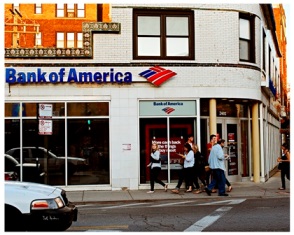Our Too-Big-To-Fail banks are at it again...
The Volcker Rule is supposed to ban the banks from making hazardous and speculative trades.
But the big banks are begging for the chance to make the same kind of moves that got us into the 2008 global credit crisis, one of the worst in the modern world.
It's like they never learned their lesson...
They're even enlisting congressional cronies to do their bidding.
One way or another TBTF banks are going to find a way to speculate us all into another crisis...
Here's everything you need to know...
Big Banks Are Trading for Trillions... At Our Expense

The truth is the banks have been fighting the Volcker Rule since it was first floated.
The Rule, named after legendary former U.S. Federal Reserve chairman of the 1980s, Paul A. Volcker, goes into effect in 2015 and has lots of moving pieces.
For instance, it says banks can't have ownership stakes in hedge funds or private equity shops and can't gamble in the markets like they did in their good-old "Trading for Trillions" days.
Collateralized loan obligations (CLOs) are one of the "instruments" or "products" banks still want to trade.
The Volcker Rule says they can trade the simplest version of CLOs, those that have commercial loans in them.
But they're not allowed to trade CLOs that contain bonds, or equity, or other assets papered around CLO packages.
Not that there's anything simple about collateralized loan obligations.
They're complex from the get-go. And some varieties are a lot more complex and dangerous than others, though to the naked eye they look pretty much the same.
What the banks are bitching about is how they'll be restricted in their ability to trade the CLOs they want to own. Did you catch that?
That's right: They want to "trade" these things. That's important.
A lot of the CLOs will be put together by hedge funds and private equity (PE) shops. And that's one of the big problems: Hedge fund and PE products are supposed to be off limits.
What are collateralized loan obligations anyway? Here's what they are - and why they're so outrageous.
For the most part, the ones being targeted are made up of leveraged loans. Hedge funds and private equity shops and banks make loans to commercial companies that already have above (their industry) average debt on their balance sheets, hence they are said to be "leveraged." The issuers of these loans to leveraged companies call the loans "leveraged loans." Makes sense, right?
But because leveraged loans are made to leveraged companies there may not be any buyers willing to purchase them from the original issuers, who have no intention of keeping these loans on their own books.
So, to sell them, issuers and other product factories lump a bunch of these leveraged loans into a pool.
Yes, like a giant mortgage-backed pool. And since these are leveraged loans made to leveraged companies they're a tad bit closer to those infamous subprime mortgage-backed securities.
Just because you pool a bunch of leveraged loans into a package, doesn't mean they are less leveraged, higher rated, and more desirable. That is until you add the magic elixir called collateralization, sometimes referred to as structuring.
This trick works the same way it worked for subprime mortgage pools.
The pools are sliced and diced into "traunches" that are sub-pools. These sub-pools are assigned certain rights over other sub-pools in the big pool. They may get more interest payments directed to them. They may have more collateral backing their portion of the pool. The end result is that each of the traunches have different risk and payment structures and different ratings.
And like magic the total pool becomes a series of sub-pools that will fit the bill of the investors they are structured to attract. They get sold off and everyone is happy.
The banks are crying that these products are loans, and banks are supposed to be in the loan business. They want to own these loan products even if they were originated by hedge funds or private equity shops.
It usually gets lost in translation, but I'm here to remind you. The original loans are made to leveraged companies because they are usually part of a leveraged buyout deal.
That's right, leveraged companies need more money because their LBO owners (leveraged buyout owners) want to leverage them up more to pay themselves the fees they extract for taking them private in the first place.
Or, they leverage them up to pay themselves dividends with the money they borrow from the PE shops and hedge funds who only lend it to them temporarily. No wonder they want to package them up and get them off their books.
Enter the banks. They like the yield on these loans. They want to buy them. The big banks own most of these CLOs. And they want to be able to sell them, like they can do with their other loans. If they can buy these CLOs and sell these CLOs, they are trading them, because buying and selling amounts to trading. They want to be able to trade them.
The big banks that want to play in this sandbox are enlisting their congressional cronies to do their bidding.
Andy Barr, a House Republican from Kentucky, introduced a bill recently to allow banks the latitude they demand. He was speaking on behalf of the "small banks" in his state that would have to let go employees if this seal-clubbing was allowed to continue.
It doesn't matter that small banks don't trade this stuff and the handful that buy them certainly don't have trading desks to trade them. But the big boys do.
That's why House Financial Services Committee Chairman Jeb Hensarling, a Texas republican, said the Volcker Rule is a job destroyer.
Oh, the humanity!
If big banks think these are good loans to hold, why don't they just originate them themselves and keep them on their books? Why do they want to trade them?
Maybe because if they can trade them, they can hedge them. If the big banks can hedge them, they can over-hedge or under-hedge or cross-hedge, all of which means they want to use their hedging operations to engage in their favorite game... speculative trading.
BTW: If you want the chance to make some real money on situations like these... and you don't mind going against the grain... and making Wall Street's blood boil... I'd like to show you how to do it. You'll be surprised how easy it is.
About the Author
Shah Gilani boasts a financial pedigree unlike any other. He ran his first hedge fund in 1982 from his seat on the floor of the Chicago Board of Options Exchange. When options on the Standard & Poor's 100 began trading on March 11, 1983, Shah worked in "the pit" as a market maker.
The work he did laid the foundation for what would later become the VIX - to this day one of the most widely used indicators worldwide. After leaving Chicago to run the futures and options division of the British banking giant Lloyd's TSB, Shah moved up to Roosevelt & Cross Inc., an old-line New York boutique firm. There he originated and ran a packaged fixed-income trading desk, and established that company's "listed" and OTC trading desks.
Shah founded a second hedge fund in 1999, which he ran until 2003.
Shah's vast network of contacts includes the biggest players on Wall Street and in international finance. These contacts give him the real story - when others only get what the investment banks want them to see.
Today, as editor of Hyperdrive Portfolio, Shah presents his legion of subscribers with massive profit opportunities that result from paradigm shifts in the way we work, play, and live.
Shah is a frequent guest on CNBC, Forbes, and MarketWatch, and you can catch him every week on Fox Business's Varney & Co.



